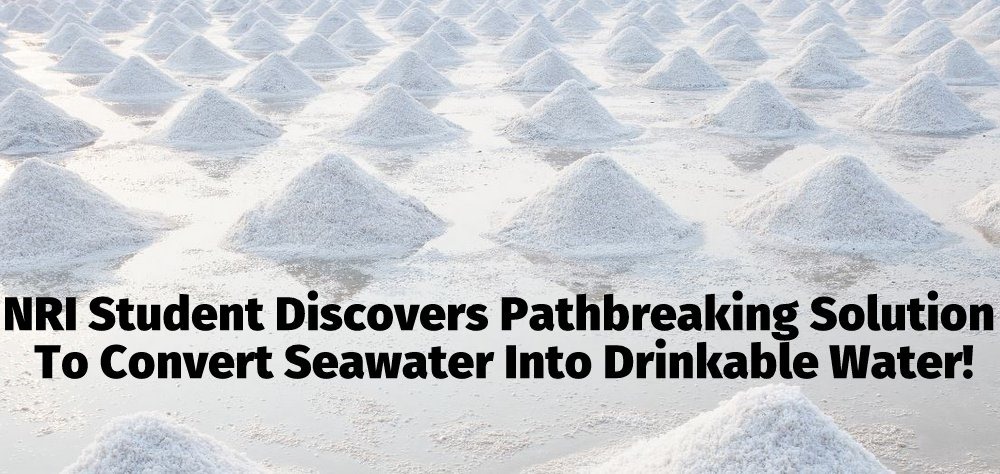NRI Student Discovers Pathbreaking Solution To Convert Seawater Into Drinkable Water!

Globally, 1800 people die from water-related diseases every day, all over the world; 2000 kids under the age of 5 die every 5 days due to water-related diseases.
In 2013, UNICEF described the situation like this: “If 90 school buses filled with kindergartners were to crash every day, with no survivors, the world would take notice. But this is precisely what happens every single day because of poor water, sanitation, and hygiene.”
Water is one of the most crucial ingredients for sustaining life, a basic human right, but still, the water crisis is more than serious at this particular point in time.
Globally, almost 700 million people cannot access one glass of drinking water a day, even as 1.2 million people died because of lack of water in 2000. Solving the water crisis is one of the most immediate requirement, and an NRI student has introduced a new, innovative way which is garnering attention worldwide.
The Water Crisis
The fact is that 71% of Earth is covered by water, but the problem is that 96.5% of this water is found in seas and oceans. Groundwater, which is drinkable by default, covers only 1.7% of the overall water found on Planet Earth, as only 2.5% of water is drinkable.
Converting sea water into drinkable water holds the key to solving water crisis of this Earth, but the existing solutions take too much capital, time and resources to make it feasible in poorer continents like Africa.
Here comes Chaitanya Karamchedu from Portland, Oregon, who is an NRI student. In his science project, he devised an innovative way to convert salt water into drinkable water, and if some serious research is done in this regard, it can actually solve the water crisis of this world.
NRI Student’s Approach To Solve Water Problem
Chaitanya’s approach involves using polymer to convert seawater into drinkable water.
And the basis of this new method are two observations:
a) 100% of seawater is not fully saturated with salt; this means that there are water bodies within seas and oceans which are very close to being drinkable
b) Traditional desalination involves understanding of bonding with water molecules, but the key is just the opposite: Understanding chemical bonding with salt, instead of water
Jesuit High School Biology Teacher Dr. Lara Shamieh said, “People have been looking at the problem from one viewpoint, how do we break those bonds between salt and the water? Chai (Chaitanya Karamchedu) came in and thought about it from a completely different angle,”
As per the research work undertaken for this small school project, Chaitanya focussed on the 90% of seawater which is not bonded with salt, and this way, introduced a brand new approach to solving water crisis.
And his work is being appreciated and observed by the Scientific community.
Recently he won $10,000 from the US Agency for International Global Development at Intels International Science Fair and won 2nd place at MITs TechCon Conference where he received more money for this research work.
Besides, he has been selected as one of the 300 Regeneron Science Talent Search Semifinalists, across the world.
Can Chaitanya’s path-breaking research result in even more efficient way to desalinate saltwater? Can it actually solve the global water crisis? Do let us know by commenting right here!
Related:
Can Sunshine Provide Clean Drinking Water? Desolenator Proves its Can [Innovation]
Next war is for water and India needs to fight it!
Indian Origin Stanford Professor Creates a Computer That Operates on Water Droplets

I am not convinced. I am not aware of any sea area that is without salt. It can be less saline in a few areas where river or land water source meets the sea. There are lots of impurities in the sea water. Cheaper solutions to convert even the dirtiest water into drinking water are already there but most solutions work only with small samples and not feasible and economical on large scale. There are many solutions already in use for turning sea water into potable water but they are expensive and require lots of power. How this solution is cheaper compared to those solutions will be known only when it is tried at commercial level.
There are lots of local and national prizes in the US for science students so winning prizes there is not difficult. Few years back, I had read about an American student who had been given all paid scientific expedition to try solar LED lamps in a village in Odisha. Some other US students were visiting a slum of Delhi for some sanitation project. It encourages them in research but it is not the proof of viability of a scientific project.